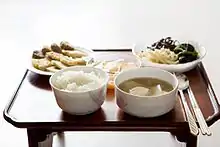Suksil-gwa
Suksil-gwa (숙실과; 熟實果), literally "cooked fruit", is a category of hangwa (Korean confection) consisting of cooked fruit, roots, or seeds sweetened with honey.[1][2] Common ingredients include chestnut, jujube, and ginger.[3] Suksil-gwa is similar to—and sometimes classified as—jeonggwa, but has unique characteristics that differentiate it from the jeonggwa category.[2]
| Type | Hangwa |
|---|---|
| Place of origin | Korea |
| Associated national cuisine | Korean cuisine |
| Main ingredients | Chestnuts, jujube, ginger |
| Ingredients generally used | Honey, cinnamon powder, pine nuts |
| Korean name | |
| Hangul | 숙실과 |
|---|---|
| Hanja | 熟實果 |
| Revised Romanization | suksil-gwa |
| McCune–Reischauer | suksil-kwa |
| IPA | [suk̚.ɕ͈il.ɡwa] |
 |
| This article is part of a series on |
| Korean cuisine 한국 요리 조선 료리 |
|---|
It has been mainly used for special occasions such as janchi (banquet), or jesa (ancestral rite).[3] During the Joseon era (1392–1897), it was consumed by yangban (scholar-officials) and in royal court cuisine, due to the requirement for good quality fruit and an elaborate cooking process.[4] Suksil-gwa is usually served with two or three kinds in one dish.[3][4]
Varieties
Suksil-gwa can be divided into ran-type and cho-type by the cooking method. Each of the terms is affixed to the main ingredient.[2] The ran-type involves meshing of the cooked ingredient, mixing them with honey, and shaping the mixture into the shape of the fruit. The cho-type are made without the meshing process.[2]
- Yullan (율란; 栗卵) – made by mashing and sieving boiled and peeled chestnuts, mixing the sieved chestnut with cinnamon powder and honey into a dough, then shaping the dough into chestnut-shaped confection and garnishing it with pine nut powder.[3][5]
- Joran (조란; 棗卵) – made by mashing and sieving boiled and deseeded jujube, mixing the sieved jujube with cinnamon powder and honey into a dough, then shaping the dough into jujube-shaped confection and optionally garnishing it with pine nut powder.[3] Sometimes, joran can be filled with the mixture of chestnut powder and honey.[6]
- Saengnan (생란; 生卵) – also referred to as gangnan (강란; 薑卵) or saenggang-ran (생강란; 生薑卵), made by boiling peeled and finely minced ginger in a lot of water to reduce the heat, sieving it, simmering it in honey, cooling it, and shaping it into ginger-shaped confection and garnishing it with pine nut powder.[3][7]
- Bamcho (밤초) – also referred to as yulcho (율초; 栗炒), made by simmering peeled chestnuts in water, with honey of the same weight as chestnuts added.[3] When the honey penetrates the chestnuts, cinnamon powder is added and the confection is drained and coated with pine nut powder.[3] Both dried and fresh chestnuts can be used to make bamcho.[8]
- Daechu-cho (대추초) – made by deseeding jujube, steaming it for a short time and stuffing it with around two pine nuts, simmering the stuffed jujube with honey and cinnamon powder, and coating it with pine nut powder.[3] When served, daechu-cho is garnished with a toasted pine nut on the stalk end of the jujube.[9]
References
- Kwon, Yong-seok; Kim, Young; Kim, Yang-suk; Choe, Jeong-sook; Lee, Jin-young (2012). "An Exploratory Study on Kwa-Jung-ryu of Head Families" (PDF). Journal of the Korean Society of Food Culture (in Korean). 27 (6): 588–597. doi:10.7318/kjfc/2012.27.6.588. Retrieved 26 July 2017.
- "Suksil-gwa" 숙실과. Doopedia (in Korean). Doosan Corporation. Retrieved 26 July 2017.
- 염, 초애. "Suksil-gwa" 숙실과. Encyclopedia of Korean Culture (in Korean). Academy of Korean Studies. Retrieved 26 July 2017.
- "Kinds of Hangwa: Suksilgwa (Boiled down Fruit Cake)". Food in Korea. Korea Agro-Fisheries Trade Corporation. Retrieved 26 July 2017.
- "Yullan" 율란. Standard Korean Language Dictionary (in Korean). National Institute of Korean Language. Retrieved 26 June 2017.
- "Joran" 조란. Standard Korean Language Dictionary (in Korean). National Institute of Korean Language. Retrieved 26 June 2017.
- "Saengnan" 생란. Standard Korean Language Dictionary (in Korean). National Institute of Korean Language. Retrieved 26 June 2017.
- "Bamcho" 밤초. Standard Korean Language Dictionary (in Korean). National Institute of Korean Language. Retrieved 26 June 2017.
- "Daechu-cho" 대추초. Standard Korean Language Dictionary (in Korean). National Institute of Korean Language. Retrieved 26 June 2017.